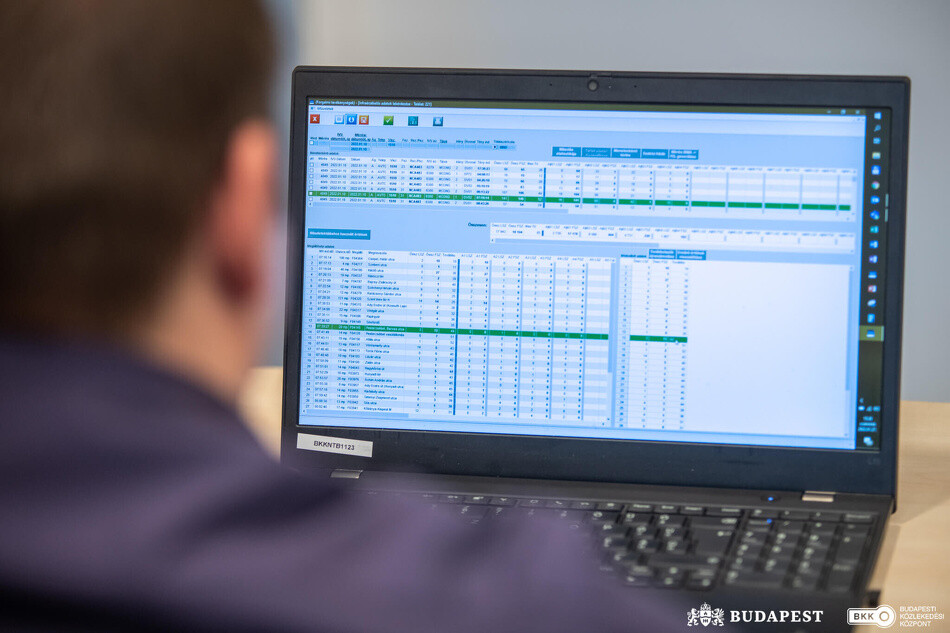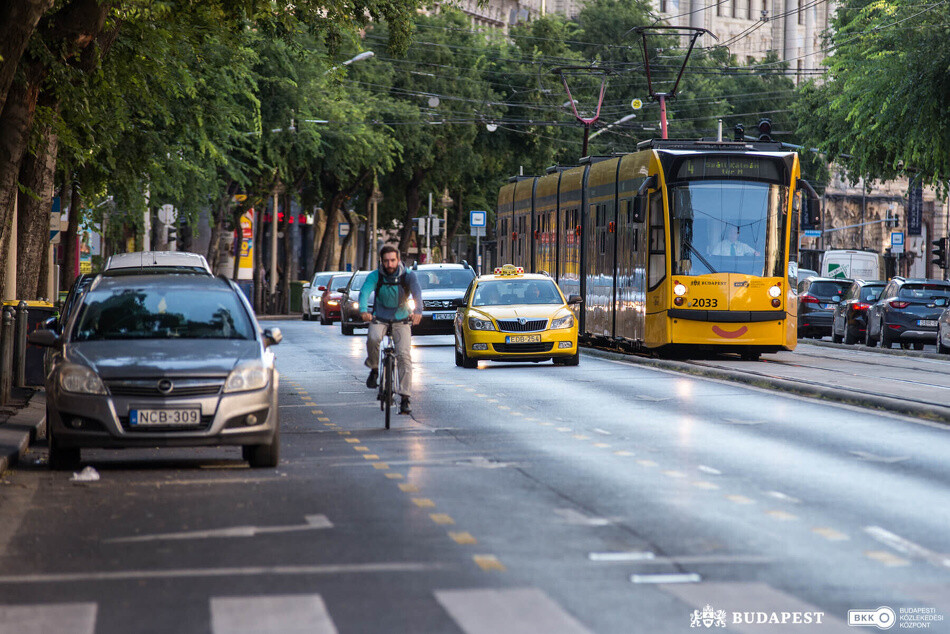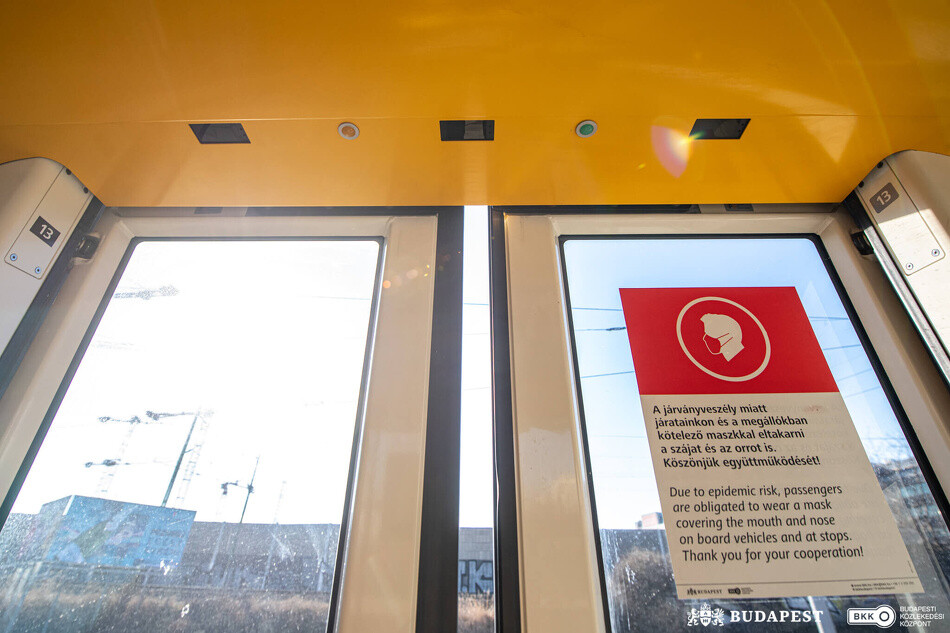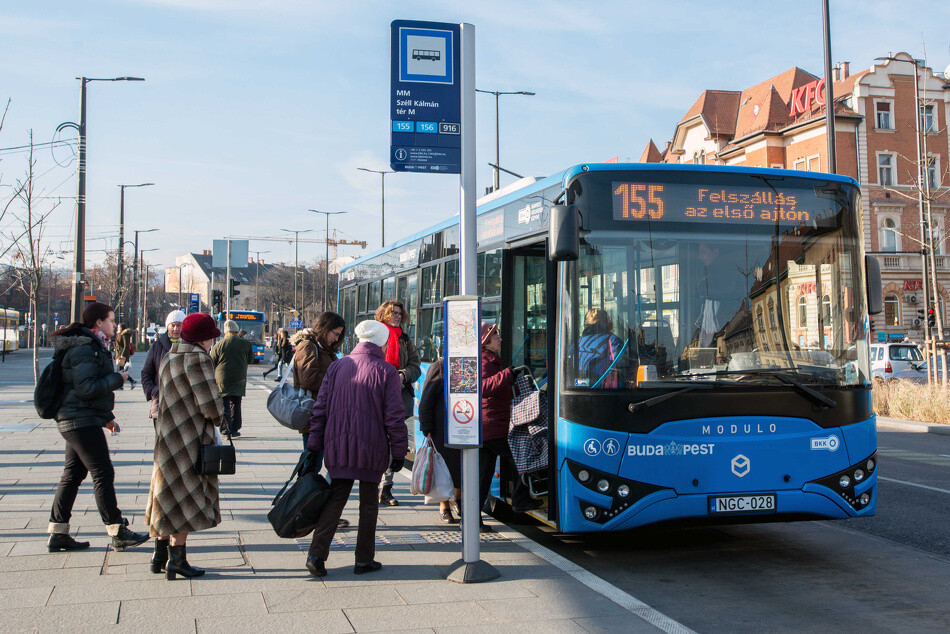
CONTENT
Why is it required to collect data?
What type of data are available at BKK?
Categorisation by the type of data
How are data collected?
Categorisation by the methodology of data collection
Categorisation bv the mode of data collection
Categorisation by data source
What goals does BKK use the collected data for?
Development trends
Why is it required to collect data?
Our vibrant city is under constant development, simultaneously with which, our mobility demands are being formed on a continuous basis. Furthermore, the mobility services, the infrastructure and mobility-related habits all make an impact on the creation of settlements and the environment, on the design of urban public spaces and also on the quality of life in residential areas. In case we wish to understand these processes and influence them by our decisions, it is essential to acquire appropriate data.
Data used and managed by BKK can be categorised in the following aspects:
- based on type of the transport mode: public transport users, micromobility users (e.g.: cyclists or scooter riders, etc.), pedestrians (active road users), road users (motorists using private cars and also other participants of road transport),
- based on the type of the data: quantitative (such as the number of passing vehicles) and qualitative data (such as categories of the passing vehicles).
Even the data collection-related activity can be categorised in the following different aspects:
- by the methodology of data collection: under this category, we are interested in the characteristics of the collected data (cross-sectional or destination-related data),
- by the data collection method: What kind of tools are used for the data collection (by on-site measurement through observation, by device, big data or through interviews), and
- by the data source (external - internal),
The classification based on transport modes and the differentiation by the type of data fully indicates the type of data currently collected and managed by BKK, while the categorisation based on the method of the data collection sheds light on how data is are collected. Besides the type of data and the method of data collection it is important to specify the goals BKK uses the collected data for.
What types of data are available at BKK?
In the course of data collection carried out in in the topic of traffic and transport safety by BKK and its external partners, data are collected about the different transport modes (about public transport users, micromobility users, pedestrians and road traffic). Data about various transport modes are collected in different ways. Data are collected on a regular basis typically in case of transport modes that could be measured by a counting device (currently, buses, trolleybuses, certain trams, and also cycling and road transport), while in case of other transport modes, data are collected occasionally through observations.
In the current practice, even data collection carried out by a counting device contains compromises, which is due to the number and condition of the vehicle fleet equipped with a counting device, in case of public transport, while is due to the finite number of vehicle fleet, in case of the other transport modes. In case of public transport modes equipped with a counting device (buses, trolleybuses and certain trams), it is not possible to measure all lines at the same time. Regarding to cycling and road traffic measured by a counting device, data can only be perceived at a limited number of spots, due to the location-bound characteristics of the counting devices.

- Data collected about public transport users
In relation to public transport, BKK collects data about passenger traffic (passengers boarding and exiting a line, cross-sectional passenger number, vehicle utilisation), service (daily, peak hours, uniquely-specified daytime), travel habits (goal of a trip, spatial and temporal characteristics of a trip, reasons behind the choice of a transport mode, demographic data of passengers) and also about ticket and pass sales, customer satisfaction via data service supplied by its own or by an external partner.
- Data collected about micromobility users
In case of micromobility users, BKK collects data about the number of cross-sectional transits, the spatial and temporal characteristics of a trip and also about travel habits (goal of a trip, reason behind the choice of a transport mode) via data service supplied by its own or by an external partner.
Among the shared micromobility devices, travel-related data (spatial and temporal characteristics of a trip), data specifying the fleet size, data describing the current situation and the condition of the vehicle fleet is available from the MOL Bubi public shared bike system. Currently, regarding to the shared devices apart from the MOL Bubi public shared bike system, only the estimated size of the fleet size is known. Travel data, similar to the MOL Bubi system is are currently unknown, in case of services of the other shared devices.
- Data collected about pedestrians
In case of pedestrians, BKK collects data about the number of cross-sectional transits, spatial and temporal characteristics of a transit and also about travel habits (goal of a trip, reason behind the choice of a transport mode) via data service supplied by its own or by an external partner.
- Data collected about road users
In case of transport-related data collection, BKK collects data about the cross-sectional traffic volume, the speed of the transit, the direction of the transit, travel habits (goal of a trip, spatial and temporal characteristics of a trip, the reason behind the choice of a transport mode, the demographic data of passengers) and occasionally, also about the share of vehicle categories via data service supplied by its own or by an external partner. On an occasional basis, data about parking-related characteristics (parking time, utilisation), vehicle utilisation are collected and the emission rate is deduced from the collected data.
Currently, data specifying the use of shared cars and scooters is are unknown, however BKK intends to conclude an agreement for this purpose in the future.
Categorisation by the type of the data
In case of the collection of quantitative data, data presenting the quantitative characteristics of traffic are collected, with which a detailed database can be established in relation to the
- traffic volume,
- traffic direction,
- its duration and
- the transport mode(s), by which the trip is taken,
- line(s) and
- line-related data.
In the course of the collection of qualitative data,
- the reason of a trip and the selection of a transport mode,
- and the purpose of a trip can be examined, from which, the details of a trip and travel habits can be deduced, following detailed, compared analyses.
During BKK’s data collection-related activities and the data service provided by its external partners, quantitative data has been collected regularly for the past four decades, among the two types of data collection methods, therefore even historical data is available about the quantitative data. Qualitative data had been previously collected typically on an occasional basis, during household surveys or in the framework of different research. The share of the two types of data collection methods significantly shifts to the quantitative data collection method.
How are data collected?
The data collection activity can be categorised based on different aspects.
Categorisation by the method of data collection
In the course of cross-sectional data collection, the data of traffic volume at a given cross-section of a road, public space or public transport network are examined. The data obtained with this type of data collection provides information about the burden of the cross-section on a road or at a public space as per passenger traffic or transport mode. Cross-sectional data are collected upon the data collection of public transport-related passenger flow, upon the counting of the traffic volume of cycling and road transport at counting points and typically upon the traffic calculation carried out by observation.
In the course of data collection carried out in relation to the destinations, the spatial and temporal characteristics of a given trip are examined, while the traffic flows, transport habits and the selection of transport modes are identified.
Currently, typically cross-sectional data are collected by BKK and by its partners carrying out data service. Due to its capacity demand, data collection was carried out about the destinations only occasionally, but since 2021, BKK raised data collections to the next level and in the event of research projects, destination-related data and other transport habits are measured at regular intervals.
Categorisation by the mode of data collection
Regarding to the mode of data collection, we can differentiate among data collection through observations, by a device and through on-site interviews.
- Data collection through observations
In case of transport modes or locations that cannot be currently measured by a counting device, data is are collected occasionally, in connection with special periods or transport service changes or timetable modifications on-site through observation. Data collection through observation is carried out prior to, during and even after the planned particular interventions, so that the changes could be followed properly BKK applied the observation method in 2021 during the entire passenger counting activity of metro line M4 and while tracking the performance of the transport network modifications during a special period arising due to the reconstruction of the Széchenyi Chain Bridge, as a complementary method of data collection carried out by a device.
With the help of the observation method, despite the fact that it could seem to be an obsolete method, compared to the data collection carried out by a device, several, more sensitive data can be obtained that otherwise could not be measured by a device (e.g. share of genders, the users of individual or shared transport modes within the sector, etc.).
- Data collected by devices
In the course of data collection carried out by a counting device, it is possible to collect data for an entire day from the first departure to the last departure of a line, by a counting device installed on a vehicle or at a public space. Based on their instalment location, counting devices displayed at public spaces can be either sensors, installed on the surface of the carriageways or devices analysing a camera image.
Thanks to the constant data service, BKK uses the data collected by devices for the analysis of daily traffic-related data, timetable modifications and network development. Mobility reports, released every month are typically based on these types of data. In fact, the attention towards the existing demand to operate services on the airport bus line 100E more frequently from 25 October 2021 was also indicated by data collected by these devices.
Currently, BKK and its partners carry out data service collect data by device on a daily basis. With the help of this type of data collection method, cycling and road traffic data can be measured besides certain modes of public transport (buses, trolleybuses and certain trams), services.

Only a certain proportion of the approximately 4.23 million workday trips taken before the pandemic by public transport services could be measured with the set of counting devices currently in operation.
Only a certain proportion of buses, trolleybuses and trams, a total of 728 vehicles are currently equipped with a counting device. With the existing counting devices, a significant number of the bus network consisting of 190 lines can be measured. Nearly half of the trolleybus network consisting of 15 lines can be measured, while out of the 34 tram lines, - the ones where CAF vehicles operate - can be measured.
Vehicles equipped with a passenger counting device are operated on different lines on a continuous basis along BKK’s network, taking into account that the most wide-ranging possible data collection could be provided. Besides public transport data, significantly less information are available about the traffic volume, and the travel habits of the other transport modes. Data related to cyclists – including other micromobility users riding in the bike lane – and road transport data can be measured by a device, while in case of scooters (or other micromobility users) and pedestrians, data measured by a device are not available.
The rate of cyclists and other micromobility users can be measured by a detector installed at 14 spots - at Árpád híd, at Bem rakpart Hungária körút, Weiss Manfréd út, Népfürdő utca, the Műegyetem rakpart, Batthyány utca, Jászai Mari tér, Városmajor utca, Múzeum körút and at the intersection of Teréz körút – Szondi utca.
Among the shared bike and other micromobility users, BKK is familiar with the data of the MOL Bubi public shared bike system, while data pertaining to external market service providers have not been available to the company so far.

Information are obtained on road transport through 704 loop detectors installed on the surface of the carriageways and also through 47 cameras. These devices are not operated by BKK, but the data is are perceived by the company.
The device based on the analysis of the detector and the camera image measures the same data: traffic volume on a given cross-section and the average speed resulting from the transit of a car over the in-built detector. To make a difference between the two devices, the process of camera images is more accurate, however the cameras react to the changes of their environment in a more sensible way and they are costlier, compared to the loop detector devices.
- Data collection through interviews
The data collection carried out through interviews enables us to get familiar with other – primarily with qualitative data, in addition to destination-related data. During the application of this method, focus-group and household interviews are conducted. This method sheds light on the most up-to-date travel habits and the transport modes choices, giving answers to the direction of the journey, the time the journey is taken and the reason of the choice of the particular transport mode during the journey. Furthermore, subjective observations, experience, suggestions and constructive criticism can be gained, which can be useful and advantageous during transport organisation and development. A good example for regular interview-based data collection are the household interviews made for the fine-tuning of the unified traffic data model traffic in the Hungarian capital and in its metropolitan area.
Categorisation source by the source of the data
The data catalogue concentrated at BKK not only consists of the information collected by the company, but also the data measured by the external partner carrying out different data service. Therefore, based on the categorisation by the source of the data, we can distinguish between the data collected by BKK and the data collected by an external partner. External partners are considered to be Budapest Közút (Budapest Public Roads), which operates the loop detectors installed in the cover of a road (704 pieces in total) and cameras (47 pieces in total), BKV (Budapest Transport Privately Held Corporation), ArrivaBus and Volánbusz (the regional bus service provider) operating public transport vehicles as well as each and every company or organisation that provide data service to BKK.

For what goals does BKK use the collected data?
The scope of use of the accessible data collected by BKK during data service are in connection with the transport mode that the data provide information about.
One profile of BKK is to develop the level of its public transport services on a continuous basis, while providing a high-quality passenger comfort Therefore, in relation to public transport, BKK serves the following tasks through its data collection activity and the use of data received in the course of data service:
- operative capacity planning that meets the real demands,
- constant monitoring of the operation of public transport services and travel habits,
- traffic calculation in periods before and after network development or timetable-related changes
All in all, BKK aims to achieve the improvement of its services and the increase of passenger experience.
The underlying practical experience, among others, is the network modification related to the closure of the Széchenyi Chain Bridge, changes in passenger traffic measured in case of bus lines 8E, 105, 110, 110E, 112, 178 during the follow-up of the network modification,Furthermore, bus lines 21, 21A and 212 measured throughout the summer of 2021 for the service improvement in the area of Normafa.
Prior to and during the reconstruction works of metro line M3, passenger traffic of replacement bus M3 and also frequent services of relating feeder and alternative lines were monitored several times, in order to make the replacement of metro line M3 as smooth as possible.
BKK has recently continued to extend its front-door-boarding policy on more lines. These lines are monitored on a continuous basis, due to the increased time during the passenger exchange that might occur as a reason of the changes.

BKK, as a mobility and public space developer uses the collected data to analyse traffic changes, to familiarise itself with the actual mobility trends and also to examine different situations induced by traffic changes. The listed data can indicate - in case of unnecessary capacity or in the lack of capacity - the courses to be followed and intervention-related possibilities of infrastructure development.
For instance, BKK releases reports about the mobility trends and cycling traffics on a monthly basis, which describe the traffic characteristics of the different transport modes and even present them in a timeline. In the near future, BKK aims to achieve that the collected data and conclusions drawn from the collected data should be considered on a regular basis in the preparatory works of infrastructure development projects.
Development trends
BKK aims to develop a data strategy dealing with traffic-related data about the probable future trends of data collection and data processing and also about relating concepts. This strategy would aim to set and specify the most important objectives along a unified vision considering the strength and weaknesses of the actual situations, in the theme of collection and processing of data and also assign a toolkit to the intervention-related opportunities. In practice, it is intended to achieve that transport habits could be perceived and the widest possible scope of data could be available, ensuring data-based decision making, which, by increasing travel experience and the efficiency of transport modes, and by decreasing negative environmental impacts and other transport-related adverse effects, could contribute to the provision of a well-balanced, environment-conscious and liveable urban life.
With the advanced development of data strategy, BKK’s blog continues to provide more information about the vision of data collection data processing and also about the objectives to be met.


